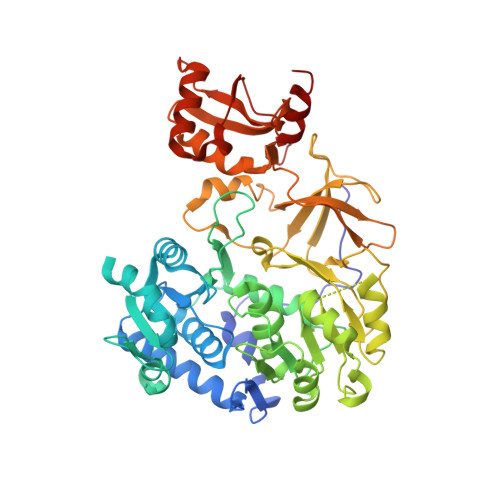Crystal structures of a Populus tomentosa 4-coumarate:CoA ligase shed light on its enzymatic mechanisms
Hu, Y., Gai, Y., Yin, L., Wang, X., Feng, C., Feng, L., Li, D., Jiang, X.N., Wang, D.C.(2010) Plant Cell 22: 3093-3104
- PubMed: 20841425
- DOI: https://doi.org/10.1105/tpc.109.072652
- Primary Citation of Related Structures:
3A9U, 3A9V, 3NI2 - PubMed Abstract:
4-Coumaric acid:CoA ligase (4CL) is the central enzyme of the plant-specific phenylpropanoid pathway. It catalyzes the synthesis of hydroxycinnamate-CoA thioesters, the precursors of lignin and other important phenylpropanoids, in two-step reactions involving the formation of hydroxycinnamate-AMP anhydride and then the nucleophilic substitution of AMP by CoA. In this study, we determined the crystal structures of Populus tomentosa 4CL1 in the unmodified (apo) form and in forms complexed with AMP and adenosine 5'-(3-(4-hydroxyphenyl)propyl)phosphate (APP), an intermediate analog, at 2.4, 2.5, and 1.9 Å resolution, respectively. 4CL1 consists of two globular domains connected by a flexible linker region. The larger N-domain contains a substrate binding pocket, while the C-domain contains catalytic residues. Upon binding of APP, the C-domain rotates 81° relative to the N-domain. The crystal structure of 4CL1-APP reveals its substrate binding pocket. We identified residues essential for catalytic activities (Lys-438, Gln-443, and Lys-523) and substrate binding (Tyr-236, Gly-306, Gly-331, Pro-337, and Val-338) based on their crystal structures and by means of mutagenesis and enzymatic activity studies. We also demonstrated that the size of the binding pocket is the most important factor in determining the substrate specificities of 4CL1. These findings shed light on the enzymatic mechanisms of 4CLs and provide a solid foundation for the bioengineering of these enzymes.
Organizational Affiliation:
National Lab of Biomacromoleucles, Center for Structural and Molecular Biology, Institute of Biophysics, Chinese Academy of Sciences, Beijing 100101, People's Republic of China.














